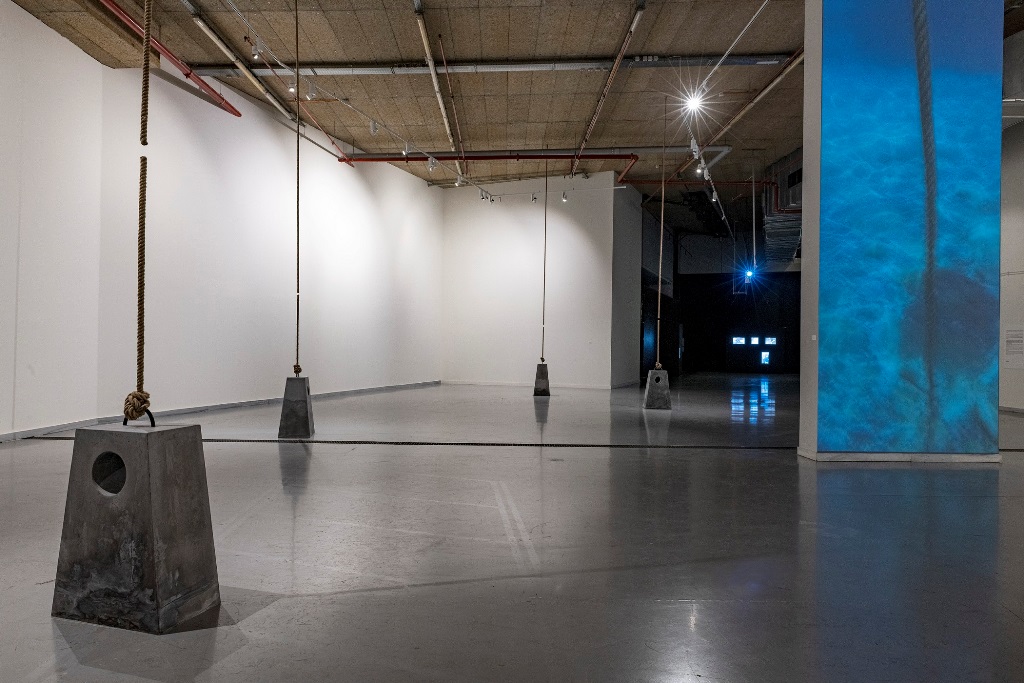Curation | Anna Kafetsi
Service Yard
Duration | 21.06.2023-29.10.2023
Opening hours | Tuesday, Wednesday, Friday, Saturday, Sunday 12:00 – 20:00
Thursdays 12:00 – 22:00 (Free admission)
Closed Mondays
Maria Papanikolaou’s monographic essay exhibition Free from what has opened to the public.The exhibition, held in the Service Yard by the Athens Concert Hall, lies within the framework of the annexM summer visual arts programme under the curatorship of Anna Kafetsi. The exhibition will last until 29.10.2023. It will remain closed from 25.7 until 4.9.
From Thursday 29.6 and every Thursday thereafter, the artist will guide the public around the exhibition (19:00 – 21:00, entrance free).
Maria Papanikolaou, one of the most important Athens-based artists of the younger generation, studied law at Athens University, sculpture at the Royal Academy of Art in the Netherlands and then Postgraduate Visual Arts at the Athens School of Fine Arts, from which she received her doctorate in 2022. In her artwork she connects sculpture, photography, video and performance in the attempt to explore a subject that has preoccupied her since her original studies at the School of Law: the limits of freedom, imprisonment and confinement, but also the potential to escape and overstep the bounds.
The exhibition – the first solo exhibition by Maria Papanikolaou in Greece – comprises 6 new productions by Maria Papanikolaou, especially conceived for the Service Yard alternative space. Minimalist in situ interventions, sculptural and audiovisual installations are presented, creating, in the almost imperceptible dialogical relationship between them, a low-toned, meditative universe. A two-hour long Lecture-performance entitled Motive, which the artist will present several times throughout the duration of the exhibition, completes the whole of the works.
Commenting on her works the artist remarks: “I use the notion of escape as a conceptual tool which works as an axis in the production of the works. Throughout human history thousands of people have tried to break free from slavery, war, poverty, totalitarian regimes, concentration camps and every other kind of prison. In the History of Art we often see the internee presented as a passive victim who deserves our pity and our sympathy. My artistic output on the contrary is based on a series of experimentations which aim at the presentation of the human being as that creative subject which comes up with ways of escape, fulfilling a basic instinct for life and freedom.
Recently I have been particularly interested in the circumstance under which a refuge is transformed into a caged environment. My works constitute suggestions for bursting the bonds which can immobilize each one of us in different oppressed situations.
In the works in the exhibition, I examine this reversal of a state of safety with that of awareness mainly through the anchor, a timeless and universal tool. Of all the types of anchors I researched, those that struck me most were the stone anchors known as anchor weights, to be found in the archeological museums in this country, whose construction is based on a simple design approximation to a weight.”
As the exhibition’s curator points out: The cryptic phrasing of the title Free from what, hovering between question and sceptical ascertainment of the artist’s verbal exergue, sets the tone for her poetic allegories to be unlocked.
Pyramidal anchors tightly bound to their cut ropes, similar to Homeric stone “ευναί,” are cast onto the seabed and drawn up from the submarine depths.
Figuratively, an intermediate transition from safety and stability to a state of stillness and immobility comes about through their settled form, giving rise to contradiction and ambiguity, rifts and actions.


